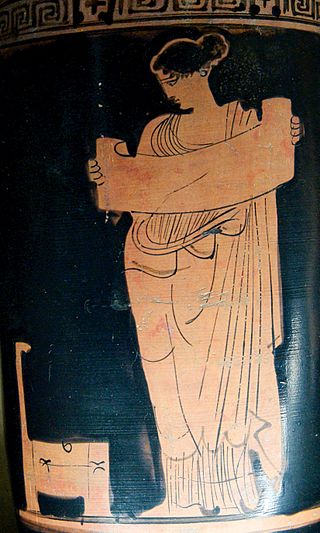Related Research Articles

In ancient Greek religion and mythology, the Muses are the inspirational goddesses of literature, science, and the arts. They were considered the source of the knowledge embodied in the poetry, lyric songs, and myths that were related orally for centuries in ancient Greek culture.

Hymen, Hymenaios or Hymenaeus, in Hellenistic religion, is a god of marriage ceremonies who inspires feasts and song. Related to the god's name, a hymenaios is a genre of Greek lyric poetry that was sung during the procession of the bride to the groom's house in which the god is addressed, in contrast to the Epithalamium, which is sung at the nuptial threshold. He is one of the winged love gods, the Erotes.
Claudius Claudianus, known in English as Claudian, was a Latin poet associated with the court of the Roman emperor Honorius at Mediolanum (Milan), and particularly with the general Stilicho. His work, written almost entirely in hexameters or elegiac couplets, falls into three main categories: poems for Honorius, poems for Stilicho, and mythological epic.
Hugh Andrew Johnstone Munro was a British classical scholar.

Marcus Verrius Flaccus was a Roman grammarian and teacher who flourished under Augustus and Tiberius.

Pervigilium Veneris is a Latin poem of uncertain date, variously assigned to the 2nd, 4th or 5th centuries.
An epithalamium is a poem written specifically for the bride on the way to her marital chamber. This form continued in popularity through the history of the classical world; the Roman poet Catullus wrote a famous epithalamium, which was translated from or at least inspired by a now-lost work of Sappho. According to Origen, the Song of Songs might be an epithalamium on the marriage of Solomon with the Pharaoh's daughter.

The Priapeia is a collection of eighty anonymous short Latin poems in various meters on subjects pertaining to the phallic god Priapus. They are believed to date from the 1st century AD or the beginning of the 2nd century. A traditional theory about their origin is that they are an anthology of poems written by various authors on the same subject. However, it has recently been argued that the 80 poems are in fact the work of a single author, presenting a kind of biography of Priapus from his vigorous youth to his impotence in old age.

Catullus 3 is a poem by Roman poet Gaius Valerius Catullus that laments the death of a pet sparrow (passer) for which an unnamed girl (puella), possibly Catullus' lover Lesbia, had an affection. Written in hendecasyllabic meter, it is considered to be one of the most famous of Latin poems.

Catullus 2 is a poem by Roman poet Gaius Valerius Catullus (c. 84 – c. 54 BCE) that describes the affectionate relationship between an unnamed puella ('girl', possibly Catullus' lover, Lesbia), and her pet sparrow. As scholar and poet John Swinnerton Phillimore has noted, "The charm of this poem, blurred as it is by a corrupt manuscript tradition, has made it one of the most famous in Catullus' book." The meter of this poem is hendecasyllabic, a common form in Catullus' poetry.
Thargelia was one of the chief Athenian festivals in honour of the Delian Apollo and Artemis, held on their birthdays, the 6th and 7th of the month Thargelion.

Oscilla is a word applied in Latin usage to small figures, most commonly masks or faces, which were hung up as offerings to various deities, either for propitiation or expiation, and in connection with festivals and other ceremonies. It is usually taken as the plural of oscillum, a little face. As the oscilla swung in the wind, oscillare came to mean to swing, hence in English oscillation, the act of swinging backwards and forwards, periodic motion to and fro, hence any variation or fluctuation, actual or figurative.
Fescennia or Fescennium was an ancient city of Etruscan/Faliscan origin, which is probably to be placed immediately to the north of the modern Corchiano, 6 miles (9.7 km) north west of Civita Castellana, in central Italy. The Via Amerina traverses it. At the Riserva S. Silvestro, walls exist. At Corchiano itself, however, similar walls may be traced, and the site is a strong and characteristic triangle between two deep ravines, with the third (west) side cut off by a ditch. Here, too, remains of two bridges may be seen, and several rich tombs have been excavated.

Klemens Janicki (1516–1543) was one of the most outstanding Latin poets of the 16th century.
Latin obscenity is the profane, indecent, or impolite vocabulary of Latin, and its uses. Words deemed obscene were described as obsc(a)ena, or improba. Documented obscenities occurred rarely in classical Latin literature, limited to certain types of writing such as epigrams, but they are commonly used in the graffiti written on the walls of Pompeii and Herculaneum. Among the documents of interest in this area is a letter written by Cicero in 45 BC to a friend called Paetus, in which he alludes to a number of obscene words without actually naming them.

In the theatre of ancient Greece, the choregos was a wealthy Athenian citizen who assumed the public duty, or choregiai, of financing the preparation for the chorus and other aspects of dramatic production that were not paid for by the government of the polis or city-state. Modern Anglicized forms of the word include choragus and choregus, with the accepted plurals being the Latin forms choregi and choragi. In Modern Greek, the word χορηγός is synonymous with the word "grantor".

In ancient Roman religion and magic, the fascinus or fascinum was the embodiment of the divine phallus. The word can refer to phallus effigies and amulets, and to the spells used to invoke his divine protection. Pliny called it a medicus invidiae, a "doctor" or remedy for envy or the evil eye.

A phallus is a penis, an object that resembles a penis, or a mimetic image of an erect penis. In art history, a figure with an erect penis is described as ithyphallic.

In Greek mythology, Priapus is a minor rustic fertility god, protector of livestock, fruit plants, gardens, and male genitalia. Priapus is marked by his oversized, permanent erection, which gave rise to the medical term priapism. He became a popular figure in Roman erotic art and Latin literature, and is the subject of the often humorously obscene collection of verse called the Priapeia.

In ancient Roman religion, Mutunus Tutunus or Mutinus Titinus was a phallic marriage deity, in some respects equated with Priapus. His shrine was located on the Velian Hill, supposedly since the founding of Rome, until the 1st century BC.
References
- . Encyclopedia Americana . 1920.
- This article incorporates text from a publication now in the public domain : Chisholm, Hugh, ed. (1911). "Fescennine Verses". Encyclopædia Britannica . Vol. 10 (11th ed.). Cambridge University Press. p. 292.